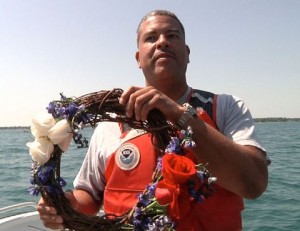
Erik Denson and several other divers laid a wreath at the site where Tuskegee Airman Frank Moody crashed his plane in 1944. (Photo by Michael Cottman)
For Erik Denson, a NASA engineer at the Kennedy Space Center, descending 30 feet into the depths of Lake Huron to help preserve the legacy of the Tuskegee Airmen was a cherished, unforgettable experience.
“I embarked on a mission of a lifetime,” said Denson, a graduate of Howard University. “One that would touch our hearts and souls.”
Early last summer, Denson and six other underwater explorers made history by conducting a five-day archeological survey of a Bell P-39Q Airacobra fighter plane piloted by 2nd Lt. Frank Moody, a 22-year-old Tuskegee Airman from Los Angeles.
After crashing his plane on April 11, 1944, Moody’s body washed ashore in Port Huron, Michigan, a few months later.
The Tuskegee Airmen were a group of fighter and bomber pilots who fought in World War II and were the first Black military aviators in the U.S. Armed Forces.
Moody was flying a training mission over Lake Huron when his aircraft malfunctioned. He was one of seven documented Tuskegee Airman whose planes nose-dived into the Great Lakes as they trained to battle the Nazis in Europe.
David Losinski, a helicopter pilot with the Oakland County Sheriff’s Office, and his son, Drew, were in a boat helping the Michigan Department of Environmental Quality on an unrelated project when they spotted the submerged door of Moody’s airplane. Losinski discovered Moody’s plane on April 11, 2014 — 70 years to the day after the pilot’s accident— and alerted archeologists from the Thunder Bay National Marine Sanctuary.
Denson, who works in eastern Florida, was part of the seven-person volunteer team that documented the wreckage, which included the engine, tail, gauge panel, wings and a radio. It marked the first time that black underwater explorers helped examine the remains of a submerged airplane once piloted by a Tuskegee Airman.
The African-American divers who surveyed Moody’s plane said their experience was emotionally — and historically — rewarding.
“The Tuskegee Airmen pilots were one of my inspirations for becoming an electrical engineer,” said Jay Haigler, a scuba diver from Washington who helped examine Moody’s airplane. “These brave men battled through racism while learning technical skills such as aeronautics and aerial combat fighting.”
He said the team located the plane’s wing— which was intact — and then removed seven decades worth of debris from it. “The star insignia (for the US Army Air Force Planes) could be seen on the tip of one of the wings. This was amazing to see this image. My heart was filled with emotion, my eyes filled with tears. This image was bringing Officer Frank Moody to life, Haigler said.
The members of the team found an intact cockpit window. “The last person who probably looked through this glass,” Haigler said, “was Officer Frank Moody.”
Moody was born in Castle, Oklahoma, on Dec. 18, 1921, according to historians. He entered the United States Army and graduated from Tuskegee University on Feb. 8, 1944 with the rank of 2nd Lieutenant. Moody’s fighter craft was part of a four-plane flight that had taken off from Selfridge Field, an aviation-training facility near Mount Clemens, Michigan, Lusardi said.
Military investigators concluded that Moody’s formation had been flying low, approximately 50 feet to 100 feet above the water, Lusardi said. They were lined up abreast with the flight leader slightly ahead when the accident occurred. Lt. Moody had just fired two bursts into the water when small pieces of debris were seen coming from the front right side of his plane. Lt. Moody’s fighter gave off a trail of black smoke, raised its nose slightly and then cart-wheeled into the lake.
When the five-day mission ended, Denson brought a wreath aboard the dive boat and asked his fellow scuba divers to say a few words to commemorate the Tuskegee Airmen. “They were heroes,” Denson said, “true American heroes.”


